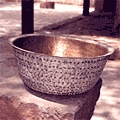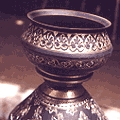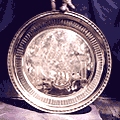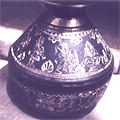Bell-metal ware – dominantly cooking ware, now supplemented with some decorative items – made in Odisha is the preserve of the kansari community, experts at this particular craft. Bishnu Sara Sahu, a mastercraftsman, describes the making of bell-metal cooking ware as a traditional craft, passed down through generations, focused within a particular set of villages in Odisha, with Chandanpur and Baghi being two of the well-known ones in the area.
The reason for traditionally making cooking ware and kitchenware from the bell-metal alloy is thatthis alloy has several medicinal properties, which the food or water kept in them acquires. These medicinal properties are derived from the medicinal properties of the individual metals in the alloy. The ability of copper to relieve joint inflammation and pain is well known in natural medicinal systems, as is the antiseptic-like effect of zinc on skin disorders. Bishnu Saha says that the bell-metal vessels, at the very least, ease the symptoms of several ailments like gastric, diabetes and allergies; he says that regular use of vessels made from this alloy can have long-term effects towards preventing and relieving several ailments altogether.
Between 200 and 300 people – all of them belonging to the same caste – in each relevant village make this cooking ware. There is a strong sense of community among these artisans, with each village having not more than 20 to 30 kilns (bhattis) where the bell-metal ingots are heated before being beaten into shape. This notion of sharing resources rather than competing for them is despite the fact that the artisans in each village specialises in the production of only a particular item: a village produces either cooking vessels, or bowls, or plates, or ladles. Naturally, as Bishnu Saha clarifies, despite the specialisation, most artisans can make all the various items – a person who makes bowls is of course equipped to make plates, and vice versa. However, they prefer to specialise in one particular item, and to experiment and innovate with shapes, textures and finishes.
The artisans who make bell-metal cooking ware also make items only of brass or copper; however, bell-metal ware remains their speciality. Predominant items include kitchen utensils like cooking pots and pans; serving vessels and ladles; and plates, glasses and bowls to eat from and drink in. Cooking ware is the traditional bell-metal product made by the kansaris and remains the staple product.
RAW MATERIALS & TECHNIQUES
Bell metal is made from a combination of copper, zinc, tin, iron and mercury. Bishnu Sahu elaborates on the proportions: one kilogram of copper is mixed with 270 grams to 300 grams of tin, about 50 grams of zinc, 5 grams of iron, and a pinch (chadam) of mercury. The metals are mixed together and worked into ingots. The ingots are heated to make them malleable, and are then beaten into the desired shape; the process of heating the metal alloy and beating it further into shape continues till the required shape and size have been achieved. The metal is beaten with an iron hammer that is usually between 500 grams and 700 grams in weight. The women sometimes help in the heating of the ingots and in the initial beating.

This process of ‘beaten metal work’ is quite distinct from the ciré perdue or lost wax process that is often used for metal casting. However, as Bishnu Sahu explains, unlike cast metal objects, the beaten kind of metalware cannot break; it will bend if extreme heat or pressure is applied to it but the process of beating enhances malleability and tensile strength. The only points along which a beaten cooking vessel can be broken are along the welding lines, should the pieces have been created by welding two or more pieces together, which they sometimes are.

After the required shape has been created, the bell-metal item is left to cool. The colour of the ware shaped from ingots is a sooty black. For those items that have been made as cooking ware, the outside of the vessel is left black: the vessel can be and is placed directly on a fire while being used for cooking. The flat base of a vessel is coated with lac and tin oil: the bottom surface is heated and stuck to the lac, and then coated with tin oil. This coat is necessary for creating a surface at the bottom of the vessel that is thick enough to prevent food from sticking to the inside surface of the base while the vessel is on the fire.
Though the outside is most often left a natural sooty black, the inside surface of the cooking ware is scratched and the black coating peeled off. A metallic finish, a warm and mellow yellow-brown gold colour, is thus achieved. The scratching and peeling is done with a knife-like instrument that Bishnu Sahu calls ‘neheni‘. Sometimes, the scratched surface is buffed to achieve a more even and polished look. Plates and ladles are scratched and buffed on both sides, and pitchers for storing water are also scratched even on the outside to prevent them from absorbing and storing heat which a smoky, black exterior would do.


PRODUCTS, STYLES & DESIGNS
The Traditional Product Range
As is apparent, the primary product range made by the kansari bell-metal artisans is cooking ware. Cooking pots are usually in the shape of pots that are least wide in diameter at the top and most wide in the middle; the pots usually have rims that curve outwards. Although these pots come in various all sizes, yet vessels with a height of around 20 centimetres to 25 centimetres and a diameter of about 20 centimetres at the centre (the widest section) are fairly common Bowls are usually open-faced, with only minor variations in the diameter of the top, middle, and bottom sections. These bowls come in several sizes, ranging from finger-bowl sized pieces to fairly large ones that can be the size of a medium-sized cooking vessel. Often there is little demarcation between bowls used for cooking, those used for serving and those used for eating: even small bowls usually used for eating can be placed directly on the fire.
The bell-metal plates are either flat, and look like lids (without handles) or else have the circular rim curved up a centimetre or two in the style of a traditional Indian thali. These plates are quite large, often about 30 centimetres in diameter. The largest have to correspond with (or be larger than) the mouth of the largest cooking vessel since the plates are used as lids. Ladles and spatulas are also made, including the quintessentially Indian karchi, a spatula with holes punched into it (used to drain the oil from fried food while removing it from the vessel). These spatulas have long handles to prevent the edge from becoming too hot to touch. As Indian food is eaten traditionally by hand, thus spoons and forks for eating are not made; only ladles for stirring and serving. Glasses are also made, as are fairly large pitcher-like containers for storing water in.

In addition to the traditional utilitarian cooking ware, decorative items are being included increasingly among the products created by these bell-metal craftspersons. Decorated plates, long-spouted water jars and wall hangings are common. Popular motifs include depictions of gods and goddesses, human figures and birds and animals. Floral patterns, especially vines, are common as surrounds.Geometrical patterns in relief are created by using shapes similar to the desired pattern(s). Thus, flat metal pieces of the required shape (circle, square, diamond…) and size are cut, and they are then beaten on to the plate with a hammer, thus creating an imprint of the required shape on the bell-metal item. These shapes are linked through into patterns by the craftspersons’ aesthetics and their beauty and elegance depend on individual imagination and skill.Another method of creating patterns and designs on bell-metal items, says Bishnu Sahu, is by using a method that he describes as kalamkari. The pattern and/or design is drawn on the item to be decorated and then a pen-shaped instrument (kalam = pen) , with its pointed tip made of iron (and the handle made of wood) is used to etch along the lines that have already been drawn. The surface on which the design will be etched is naturally kept black; the scratching action of the metal-tipped etching instrument along the desired lines thus scratches off the black along these lines, creating a yellow-gold metallic-coloured pattern on a black base. Thus, in a decorative plate (like on a glass or bowl), after the ingot has been beaten into the required shape, the surface to be decorated will be left the natural black colour; the etching with the ‘kalamkari’ pen along the design that has been drawn will create the stunning effect of a metallic gold pattern on a smoky black base.

Bishnu Sahu states that in one day, between five and seven people can make enough items to use up about 50 kilograms of the alloy. These items sell at a basic value of Rs 300 per kilogram in local areas, and at Rs 350 per kilogram in exhibitions and fairs. Thus, an item weighing 500 gram will be priced at between Rs 150 and Rs 175. Although this works out to a large sum of between Rs 15,000 and Rs 17,500 for a day’s work, yet these values remain an inaccurate picture of sales and prices for several reasons: at the minimum the sum of between Rs 15,000 and Rs 17,500 (for a day’s work) will be divided among half a dozen craftspersons, reducing the individual total to between Rs 2,500 and Rs 3,000; these figures represent gross rather than net earnings; the numbers represent a ‘maximum’ rather than an ‘average’ estimate; and actual sales rarely warrant this quantity of productivity.Besides regular sale of cooking, serving and eating vessels, exhibitions and fairs are important avenues of sale. Interestingly, it seems that the medicinal properties of bell metal vessels are causing them to be specifically sought by people in urban India who are re-discovering non-allopathic forms of healthcare and cures. This demand is not yet significant; neither is the demand for the decorative items overwhelming. Bishnu Saha feels that there is some form of growth, albeit slow; however, he believes that the untapped potential of bell-metal items – both as kitchen ware, and as decorative pieces – is immense, especially in urban India, and outside of the traditional bell-metal ware zone in Odisha. What seems necessary is an organised correspondence between production, demand and sale, and a lot of dissemination of information about the medicinal value(s) of this alloy.
